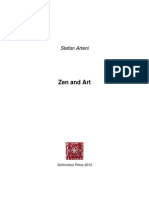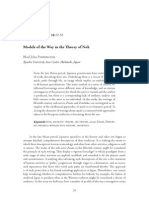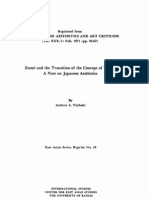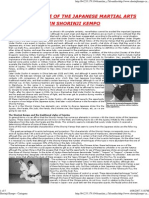Taiko Joy
Taiko Joy
Uploaded by
Si OneilCopyright:
Available Formats
Taiko Joy
Taiko Joy
Uploaded by
Si OneilOriginal Description:
Original Title
Copyright
Available Formats
Share this document
Did you find this document useful?
Is this content inappropriate?
Copyright:
Available Formats
Taiko Joy
Taiko Joy
Uploaded by
Si OneilCopyright:
Available Formats
Taiko ( ) are a broad range of Japanese percussion instruments.
Within Japan, the term refers to any kind of drum, but outside Japan, the term is often used to refer to any of the various Japanese drums called wadaiko ( ) and to the form of ensemble taiko drumming more specifically called kumidaiko ( , lit. "drum collection"). The process of constructing taiko varies between manufacturers, but must include the making and shaping of a drum body, choosing a skin for the drum head, and carefully stretching the skin over the drum head to create appropriate tension. Taiko have a mythological origin in Japanese folklore and appears to be a drumming style of Japanese origin.
? ?
" Kumi-daiko" literally means a taiko ensemble that consists of various taikos. Surprisingly, the Kumi daiko style was invented in 1950's by single person although taiko itself has a long history. Daihachi Oguchi, the founder of Osuwa Daiko, created the Kumi -Daiko style in 1951. He was actually a jazz drummer. One day, he was asked to interpret an old sheet of t aiko music for the Osuwa Shrine, which was found in an old warehouse. The sheet music was written in an old Japanese notation and he couldn't understand it at first. He, fortunately, found an old man who had performed the tune, and then he succeeded in interpreting it at last. However, as a jazz player, the rhythm pattern of the tune was too simple for him to play. He wondered why nobody played taiko together. A marvelous idea came across his mind and made him decide to break through the tradition. Inspired by a western drum set, he formed a group in which each player beats a different taiko; in short, he gave the group a function as a drum set. A high -pitched Shime-daiko established a basic rhythm like a snare drum does. A growling Nagado -daiko added accents like a bass drum. His intention was right to the point, and this epoch-making invention changed the taiko music forever. Following the Osuwa Daiko, Yushima Tenjin Sukeroku Daiko, which was based on Edo -bayashi style, was formed in 1959 by the four member s: Yoshihira Ishikawa, Yutaka Ishikawa, Seido Kobayashi, and Motoei Onozato. The characteristics of the group were the speed, powerful playing and unique choreography. Later, the group was split to two groups, the Yushima Tenjin Sukeroku Daiko and Oedo Sukeroku Daiko founded by Seido Kobayashi.
You might also like
- Ichi-go ichi-e (一期一会)Document3 pagesIchi-go ichi-e (一期一会)ruin_2832No ratings yet
- Study Guide For Nagai Kafū "The River Sumida"Document5 pagesStudy Guide For Nagai Kafū "The River Sumida"BeholdmyswarthyfaceNo ratings yet
- Masks of The Theatre in Japan.Document43 pagesMasks of The Theatre in Japan.kunstart. JJ.100% (1)
- Matter Out of Place: Carnival, Containment, and Cultural Recovery in Miyazaki's Spirited AwayDocument25 pagesMatter Out of Place: Carnival, Containment, and Cultural Recovery in Miyazaki's Spirited AwayGabrielaAmigoZapataNo ratings yet
- Shinto Perspectives in Miyazakis Anime Film Spirited AwayDocument16 pagesShinto Perspectives in Miyazakis Anime Film Spirited AwayRobert Jones100% (1)
- Manufacturing Methods For Nohkan and Ryuteki As Clarified by RadiographyDocument5 pagesManufacturing Methods For Nohkan and Ryuteki As Clarified by RadiographyJuan ValNo ratings yet
- Weidman - Guru and Gramophone Fantasies of Fidelity and Modern Technologies of The RealDocument24 pagesWeidman - Guru and Gramophone Fantasies of Fidelity and Modern Technologies of The RealscribdballsNo ratings yet
- The Transmission of Prajnaparamita BuddhaDocument4 pagesThe Transmission of Prajnaparamita BuddhaFaith JunHaoNo ratings yet
- TaikopedroDocument15 pagesTaikopedroapi-341712673No ratings yet
- Taiko ResourcesDocument17 pagesTaiko ResourcesBenjamin Pachter0% (1)
- Japanese Musical InstrumentsDocument5 pagesJapanese Musical Instrumentsjosiah venice100% (1)
- 00 - Ensemble Yonin No Kaï - Ocora Japon, Sankyoku, Ensemble Yonin No KaïDocument1 page00 - Ensemble Yonin No Kaï - Ocora Japon, Sankyoku, Ensemble Yonin No KaïRoberto MacielNo ratings yet
- REGAN Composing JapanDocument18 pagesREGAN Composing JapanFrancisco Javier González-Velandia GómezNo ratings yet
- Japanese InstrumentsDocument2 pagesJapanese InstrumentsRuel VillanuevaNo ratings yet
- Spirited Away and Japanese CultureDocument21 pagesSpirited Away and Japanese CultureShawn AngNo ratings yet
- 2010 Japanese Traditional Music EnglishDocument33 pages2010 Japanese Traditional Music EnglishNabin BajracharyaNo ratings yet
- Jin Nyodo SymbolsDocument2 pagesJin Nyodo SymbolsSantiago ButvilofskyNo ratings yet
- Correlations Between Spirited Away and Japanese MythologyDocument8 pagesCorrelations Between Spirited Away and Japanese MythologyDaniel0% (1)
- Sound JapanDocument20 pagesSound JapanRyusuke SaburoNo ratings yet
- Breathing.: Suizen Is A Zen Buddhist Practice of Meditation From Blowing AirDocument2 pagesBreathing.: Suizen Is A Zen Buddhist Practice of Meditation From Blowing AirEvan SanchezNo ratings yet
- Kopie - FukeDocument7 pagesKopie - FukeMichael Tarzaan D KučeraNo ratings yet
- Koizumi TetrachordDocument198 pagesKoizumi TetrachordRomullo QueirozNo ratings yet
- A Brief History of Japanese UkiyoDocument6 pagesA Brief History of Japanese UkiyoGavin RapelyeNo ratings yet
- Taiko DrumDocument3 pagesTaiko DrumJanine DizonNo ratings yet
- Shakuhachi Honkyoku Motivic Analysis of Sokaku Reibo Simon - AAWM - Vol - 5 - 2Document48 pagesShakuhachi Honkyoku Motivic Analysis of Sokaku Reibo Simon - AAWM - Vol - 5 - 2Antonette CabioNo ratings yet
- The Rise of Popular Arts in Pre-Modern in JapanDocument6 pagesThe Rise of Popular Arts in Pre-Modern in JapanmarkanthonycatubayNo ratings yet
- Faith of JapanDocument216 pagesFaith of JapanDawne_Berry100% (4)
- Kamis and YokaisDocument2 pagesKamis and YokaisChristian AlfornonNo ratings yet
- Japan Article: ReligionDocument5 pagesJapan Article: ReligionTara KentNo ratings yet
- StefanArteni ZenAndArtDocument99 pagesStefanArteni ZenAndArtstefan arteni100% (1)
- Iemoto System JapanDocument11 pagesIemoto System JapanilookieNo ratings yet
- Jeff Wilson-Mourning The Unborn Dead A Buddhist Ritual Comes To America-Oxford University Press, USA (2009)Document271 pagesJeff Wilson-Mourning The Unborn Dead A Buddhist Ritual Comes To America-Oxford University Press, USA (2009)trenino1662No ratings yet
- The Metamorphosis of The KappaDocument24 pagesThe Metamorphosis of The Kappaardeegee100% (5)
- History of Books and Print Culture in JapanDocument36 pagesHistory of Books and Print Culture in JapanPriscillia N'guessanNo ratings yet
- The Tale of The Heike and Japans Cultural Pivot To The Art of WarDocument10 pagesThe Tale of The Heike and Japans Cultural Pivot To The Art of WarHana SaraswatiNo ratings yet
- Japanese KabukiDocument10 pagesJapanese Kabukisjensen495100% (1)
- Grave of The Fireflies Script (Miho Nishida, Mar. 28, 1992)Document39 pagesGrave of The Fireflies Script (Miho Nishida, Mar. 28, 1992)Francesco CastagnaNo ratings yet
- Lecture 3Document67 pagesLecture 3:1 TobyNo ratings yet
- Models of The Way in The Theory of NohDocument28 pagesModels of The Way in The Theory of NohClaudia StanilaNo ratings yet
- Ukiyo eDocument3 pagesUkiyo eCecilia CeciCeciNo ratings yet
- Welcome To Tjc501 Introductory Japanese Level 3Document7 pagesWelcome To Tjc501 Introductory Japanese Level 3SYIFAA BINTI SAINEL SYIFAA BINTI SAINELNo ratings yet
- Riley Thesis v29 11 10Document267 pagesRiley Thesis v29 11 10Matias HeinNo ratings yet
- Nichiren Identified With The True BuddhaDocument3 pagesNichiren Identified With The True BuddhaNichiren Buddhism50% (2)
- Zen Buddhism and Music: Spiritual Shakuhachi Tours To Japan: November 2015Document31 pagesZen Buddhism and Music: Spiritual Shakuhachi Tours To Japan: November 2015Trần CaoNo ratings yet
- EMJ v.16 Vaporis Constantine Samurai and The World of Goods PDFDocument12 pagesEMJ v.16 Vaporis Constantine Samurai and The World of Goods PDFNatsukiPLNo ratings yet
- Zeami Yugen PDFDocument15 pagesZeami Yugen PDFberhousa100% (1)
- H812001 - Houses and Gardens of Kyoto: Assignment 3: HakusasonsoDocument5 pagesH812001 - Houses and Gardens of Kyoto: Assignment 3: HakusasonsoAnh Đỗ HoàngNo ratings yet
- Nihongo No Matsuri Latest JAPANESE FESTIVALSDocument15 pagesNihongo No Matsuri Latest JAPANESE FESTIVALSRishabh DaadNo ratings yet
- Occhi, Debra J. 2012 Wobbly Aesthetics, Performance, and Message: Comparing Japanese Kyara With Their Anthropomorphic Forebears. Asian Ethnology 71:1, 109-132.Document24 pagesOcchi, Debra J. 2012 Wobbly Aesthetics, Performance, and Message: Comparing Japanese Kyara With Their Anthropomorphic Forebears. Asian Ethnology 71:1, 109-132.15strawberryNo ratings yet
- The Life of The Mt. Fuji Ascetic Kakugyō Tōbutsu KūDocument82 pagesThe Life of The Mt. Fuji Ascetic Kakugyō Tōbutsu KūHelena LichtmeßNo ratings yet
- Ghastly Tales From The Yotsuya KaidanDocument262 pagesGhastly Tales From The Yotsuya Kaidannilarun.mannaNo ratings yet
- Hendry 1999 Introduction-Vii-16 Introduction To Social AnthropologyDocument15 pagesHendry 1999 Introduction-Vii-16 Introduction To Social AnthropologyShih Ming-RenNo ratings yet
- Bernard Herman (1911-1975) - An American Comp Composer and Conductor WhoDocument5 pagesBernard Herman (1911-1975) - An American Comp Composer and Conductor WhoWoodface1No ratings yet
- Japanese Ma Influence Onshor in JDocument5 pagesJapanese Ma Influence Onshor in JBodibodiNo ratings yet
- Bon) Are Accompanied by Singers and Sometimes Flute, Drum, and Shamisen, A Three-StringedDocument3 pagesBon) Are Accompanied by Singers and Sometimes Flute, Drum, and Shamisen, A Three-StringedOlushola AdebisiNo ratings yet
- Morris Low Building A Modern Japan Science PDFDocument258 pagesMorris Low Building A Modern Japan Science PDFRicardoNo ratings yet
- The Fluid Pantheon Gods of Medieval Japan, Volume 1 by Bernard FaureDocument495 pagesThe Fluid Pantheon Gods of Medieval Japan, Volume 1 by Bernard FaureDragonfly HeilungNo ratings yet
- SamulNori: Contemporary Korean Drumming and the Rebirth of Itinerant Performance CultureFrom EverandSamulNori: Contemporary Korean Drumming and the Rebirth of Itinerant Performance CultureNo ratings yet
- BS EthicsDocument2 pagesBS EthicsSi OneilNo ratings yet
- Lesson 4. Tax Administration.Document44 pagesLesson 4. Tax Administration.Si OneilNo ratings yet
- Faci HandoutsDocument2 pagesFaci HandoutsEurika Jade LuzonNo ratings yet
- Bayan TelDocument4 pagesBayan TelSi OneilNo ratings yet
- YFC Information SheetDocument1 pageYFC Information SheetSi OneilNo ratings yet
- SoapDocument4 pagesSoapSi OneilNo ratings yet
- TribulationDocument10 pagesTribulationSi Oneil100% (2)
- Meditation: What Kind of Authority and Power Does The Lord Want Us To Exercise On His Behalf?Document1 pageMeditation: What Kind of Authority and Power Does The Lord Want Us To Exercise On His Behalf?Si OneilNo ratings yet
- CFC Global Vision: Families in The Holy Spirit Renewing The Face of The EarthDocument3 pagesCFC Global Vision: Families in The Holy Spirit Renewing The Face of The EarthSi OneilNo ratings yet
- Jfilinvest Ii Sports Fests 2014Document3 pagesJfilinvest Ii Sports Fests 2014Si OneilNo ratings yet
- 1207 Heart - Fincial StatusDocument2 pages1207 Heart - Fincial StatusSi OneilNo ratings yet
- Bachelor of Science in BiologyDocument2 pagesBachelor of Science in BiologySi OneilNo ratings yet
- Filinvest II Sports Fests 2014Document3 pagesFilinvest II Sports Fests 2014Si OneilNo ratings yet
- Application For Student IdDocument1 pageApplication For Student IdSi OneilNo ratings yet
- BS Business AdministrationDocument2 pagesBS Business AdministrationSi OneilNo ratings yet
- BS Family Life & Child DevelopmentDocument2 pagesBS Family Life & Child DevelopmentSi OneilNo ratings yet











































































